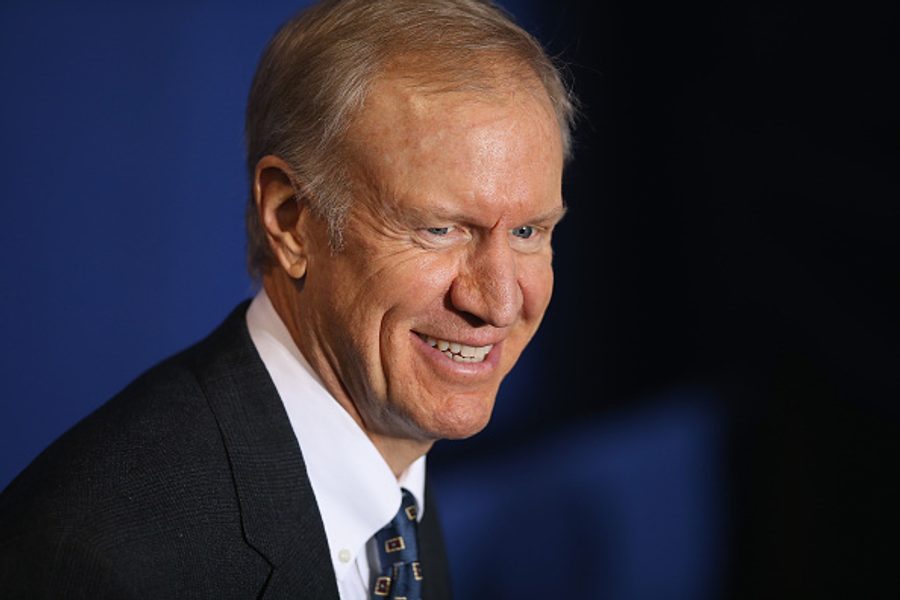Bruce Rauner’s 1 Percent-Friendly Policies Are Making Things Worse for Illinois, Not Better
The near-billionaire governor keeps insisting his policies increase opportunities for Illinoisans. But the numbers tell a different story.
Marilyn Katz

Chicago may be known as the “Windy City” because of the hot air blown by its politicians, but the loudest noise in the state these days is the giant sucking sound from Springfield, where Governor Bruce Rauner and company are attempting to further enrich the wealth of the few at the expense of everyone else.
His budget address earlier today is simply an affirmation of the path he’s followed for the painful year since his inauguration. In an attempt to fracture the growing opposition to his disregard for peoples’ need and starvation of essential institutions Rauner said he would work to increase childhood and primary education funding — knowing the price he would extract in return would be unacceptable to the unions, Democratic leaders and others who stand in the way of his attempt to drive down wages, reduce pensions and cut social services that he’s declared too rich for Illinois to afford.
Rauner’s budget address was more of what we’ve seen before — a growth agenda for Illinois predicated on impoverishing the pocket books and lives of the state’s working people.
Rauner — aided sadly by those in the media who cover Rauner’s assault as if it were a sporting match, rather than a fight in which people’s lives are at stake — claims to be carrying out a heroic battle to free Illinois from the evil, greedy unions and their stooge Democratic politicians whom he claims have crippled the state. But the reality is that as in his private corporate life — in which where Rauner exported thousands of U.S. jobs to enhance his firm’s bottom line — Rauner is not only taxing the poor to feed the rich but stifling opportunity in Illinois, now and for generations to come.
The past few years have been rough on the people of Illinois. By the end of 2015, Illinois had lost more than 1 million jobs, 795,700 of them during the Great Recession of 2007-2009 alone. At the end of the “recovery,” Illinois has experienced a net loss of 83,900 private sector jobs since the beginning of 2007 — losses that continued with another 3,000 jobs lost in 2015.
But the gross numbers don’t tell the whole story. Not only have jobs been lost; a different, poorer workforce as a whole has emerged.
In manufacturing, construction, transportation and information services, 287,400 jobs were lost during the recession years. In the main, they haven’t come back. The only significant growth areas were for jobs in leisure and hospitality, health care and retail — sectors typically associated with low wages.
While Illinois still suffers from higher unemployment than the nation as a whole (5.9 percent as opposed to the nation’s 4.9 percent), the change in the kind of jobs even those employed can get has impoverished the vast majority of people in Illinois. Those at the bottom, the lowest 20 percent, have seen a 15 percent decline in income; those in the middle have seen at least a 4 percent decline. And the median income has declined for all but the highest earners in Illinois had declined by more than $5,000 per household.
Admittedly, a decade of poor leadership — which was too interested in immediate political and personal gain — fiddled while our proverbial Rome burned. Unlike California, Massachusetts and other states that addressed the changes in the global economy by going so far as to tax themselves to create investment pool to attract tech and other job-creating industries, Illinois politicians played small ball (with many too concerned with potential indictments and upcoming challenges to their office) and forgot to create a plan forward for Illinois.
But Rauner has been no help. Adding to the 25,000 public sector jobs lost from 2010-2015, in December Illinois became number 1 in the United States for its loss of private sector jobs, posting the nation’s largest job loss (16,300).
But that doesn’t tell the whole story. Not all boats sank. During the time when the majority of Illinois incomes were sinking, some prospered considerably.
Even with the Great Recession, Illinois’s GDP grew by nearly $100 billion, from $586 billion in 2007 to $642 billion in 2015. It would have been good news if that growth had benefitted all. Instead, 97.2 percent of all income growth — that’s right, 97.2 percent — went to the top 1 percent of wage earners, with the top 1 percent enhancing their individual incomes by 35 percent while we in the 99 percent saw flat growth (0.2 percent)
As of 2012, the average income of the top 1 percent in Illinois was $1,366,958, while the average for the 99 percent was $46,000 and change. In other words, the small group of those at the top had an average income 29 times that of the rest. Today in Illinois, 50 percent of us earn less than $36,000 a year; 20 percent, less than $15,000.
Some of this is not new. Illinois has long been one of 15 states where the rich have benefitted most in recent decades, with 64.9 percent of all growth going to the top 1% since 1979. For those with a sense of history, there is a more than a degree of irony here. The 1 percent’s share of wealth in Illinois was virtually the same in 2007 as it was in 1928 — 22.5 percent in 1928, 22.8 in 2007 — before unions and battles for racial and gender equality leveled the playing field for decades. All told, since 1979, Illinois’ top 1 percent increased their incomes by 177 percent; the bottom 99 percent saw a decrease of 1.2 percent.
That the current recoveryhas benefitted only the rich underscores the mendacity of Rauner’s arguments that the greed of working peoples’ organizations greed holds the state back. The decisions and greed of those at the top that has starved the working people of Illinois of the jobs and income needed to sustain life. They are the decision makers who close or move companies to Indiana, Mississippi or China to squeeze more profit out of companies whose workers created the wealth they now appropriate.
There is trouble ahead. Those earning the most money in Illinois are not the future. The highest wage earners are over 50 (making more than 60,000 a year), while the vast majority of those under 30 make less than 30,000 per year. Only those with college degrees earn more than $36,000 a year – the minimum needed to raise a family in Illinois.
Illinois ranks number 5 out of 50 states for having the most regressive taxes with the poorest 20 percent of residents paying 13.6 percent of their income in taxes as opposed to just 4.6 percent for the top 1 percent. Rauner’s policies just make it worse.
Rauner’s war against the working and poor of Illinois began with his refusal to renew the 1.25 percent income tax surcharge that expired at the end of 2014. Rauner, who made $61 million in 2013, personally gained a $750,000 savings as did the rest of the state’s 1 percent, including our state’s 66 billionaires like Sam Zell and Ken Griffin who have joined and funded Rauner’s campaign to lower wages, destroy unions and cut government programs.
Already thousands of seniors have either lost fundamental services or must dig deeper into meagre pensions to get the help they need. Low- and moderate-income families who depend on affordable child care in order to work now find it either denied to them or more expensive — often forcing families to choose between necessary income-producing jobs and quality care for their children. Hundreds of thousands of low income and working Illinois families have seen their costs of health care rise due both to the budget impasse and Rauner’s proposal to slash health care funding moving forward.The millions of Illinois residents. Already, social service agencies that serve children, the elderly and the infirm have been crippled by the budget impasse. The state’s largest nonprofit, Lutheran Social Services, was forced to lay off 750 employees. Housing development, with the shelter and jobs they provide, are stalled as the Illinois Housing Trust Fund is held hostage.
For the people of Illinois to recover requires increases in education, the ability to work, better and better-paying jobs. Yet Rauner’s policies have been and would do just the opposite: tax the poor and middle class, lower the wages of working people and deny people the resources and investments they need to prosper.
One thousand would-be college students have already dropped out of school due to the ending of scholarship payments, and 150,000 Illinois students who rely on MAP grants to allow them to afford college — and for which there has been no funding in the current year — must now decide if they can afford the very education on which their future depends. Rauner’s slashing of funds to cities and refusal to aid Chicago and other school systems without draconian labor rights rollbacks deprives children — particularly those children of color, whose districts already suffer from disparate spending — of the teachers, books, technology and mentors they need. Rauner’s proposed $387 million cut to highereducation threatens the quality and viability of the very institutions needed to boost opportunity and income for today’s youth and places an extraordinary financial burden on the working people of the state while undermining the state’s goal of assuring that 60 percent of the Illinois workforce have college degrees by 2025.
It doesn’t have to be this way. A modest but necessary beginning would be restoring the tax surcharge. While Rauner and company gained $750,000 from its sunset, the rest of us saw a maximum saving of a meager $930 — hardly enough to begin to pay for the health care, senior care, child care, financial aid and other services that are essential for their lives.
Following up on that might be the institution of a millionaire’s tax — voted for, even during Rauner’s election, by 86 percent of Chicagoans, 80 percent of those in Cook County and a full 63 % statewide.
And this is not some wild-eyed, radical scheme. The poster boy for progressive and sound growth is Minnesota’s Governor Mark Dayton, who in his first four years in office both raised the state income tax to 9.85 percent on individuals and couple earning $150,000 and $250,000 a year respectively. Despite the dire warning of Republicans that those moves would send jobs and people fleeing, between 2011 and 2015, Minnesota actually added 172,000 jobs, achieved a budget surplus of more than $1 billion and raised individual families’ incomes.
And we need to raise the minimum wage to $15 per hour, the bare minimum a full-time worker needs to sustain a family. We have to equalize funding for schools. And, of course, pass laws requiring equal wages for women — who today head an estimated 25 percent of all Illinois households and 40 percent of the states’ families living in poverty
You might expect that the supposedly far-sighted business leaders who Rauner counts as his friends would see the wisdom of such a strategy. But they don’t. Nine wealthy families contributed half of the $65 million Rauner used to propel himself to the governor’s office. Men like Chicagoan Ken Griffin, who we learned from his quite public divorce litigation with former wife Anne Dias Griffin rakes in $68 million a month (after taxes) and billionaire Sam Zell, whose ownership of the Chicago Tribune almost ended it.
Not satisfied with gaining the governor’s mansion, many of these same billionaires have banded together in a super Pac and raised more than $14 million to convince the rest of us that we are the ones who make too much money.
Completing the irony, last spring a group of wealth Chicagoans gathered at a charitable event to hear Sam Zell opine on the future of investing. He told the group that the main impediment to growth was wealth redistribution. Where he saw real opportunity was not in Illinois (even though his hand-picked governor had surely contained wealth redistribution in his home state) was in India and Colombia.
So it goes. The billionaires without loyalty to place or person take the wealth extracted from city and citizen and sends it abroad to better exploit workers there. As for the charity event, $1.6 million was raised for Invest for Chidren, which funds seven child-focused agencies in Illinois.
Given the cuts in taxes and services that Rauner has proposed and that Zell, Griffin are supporting, the state’s children will need a lot more charity than that.








